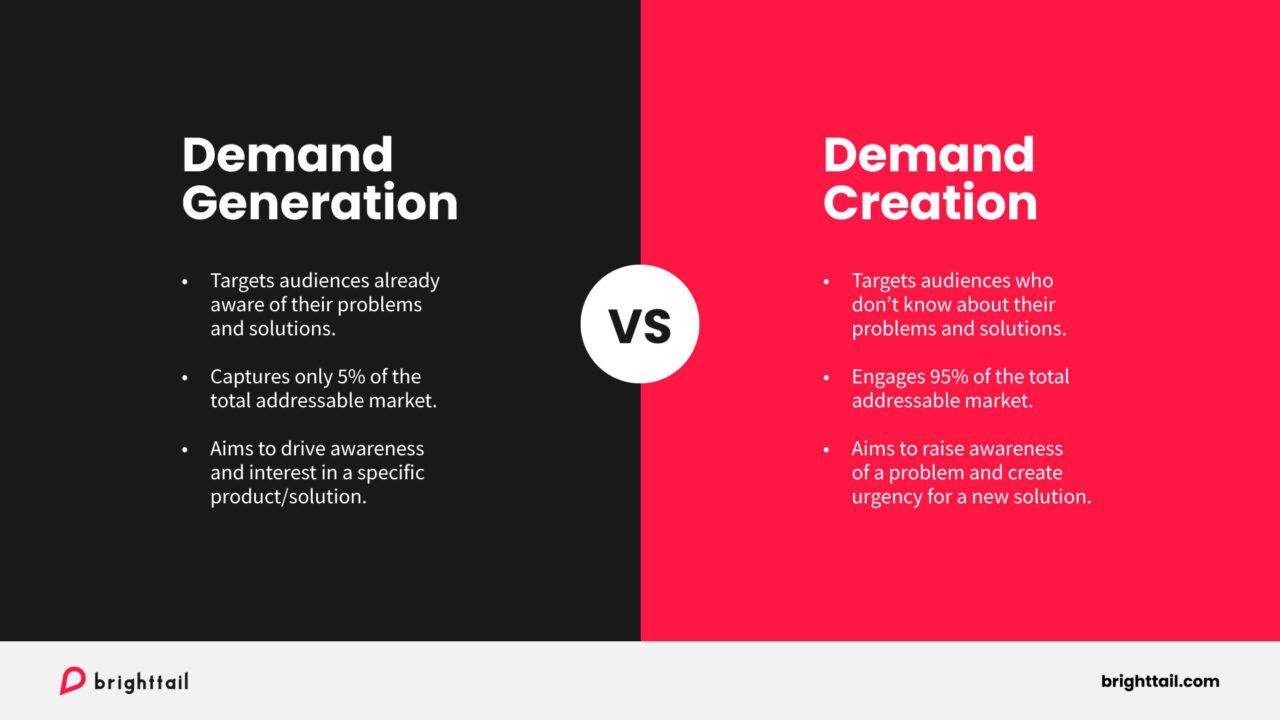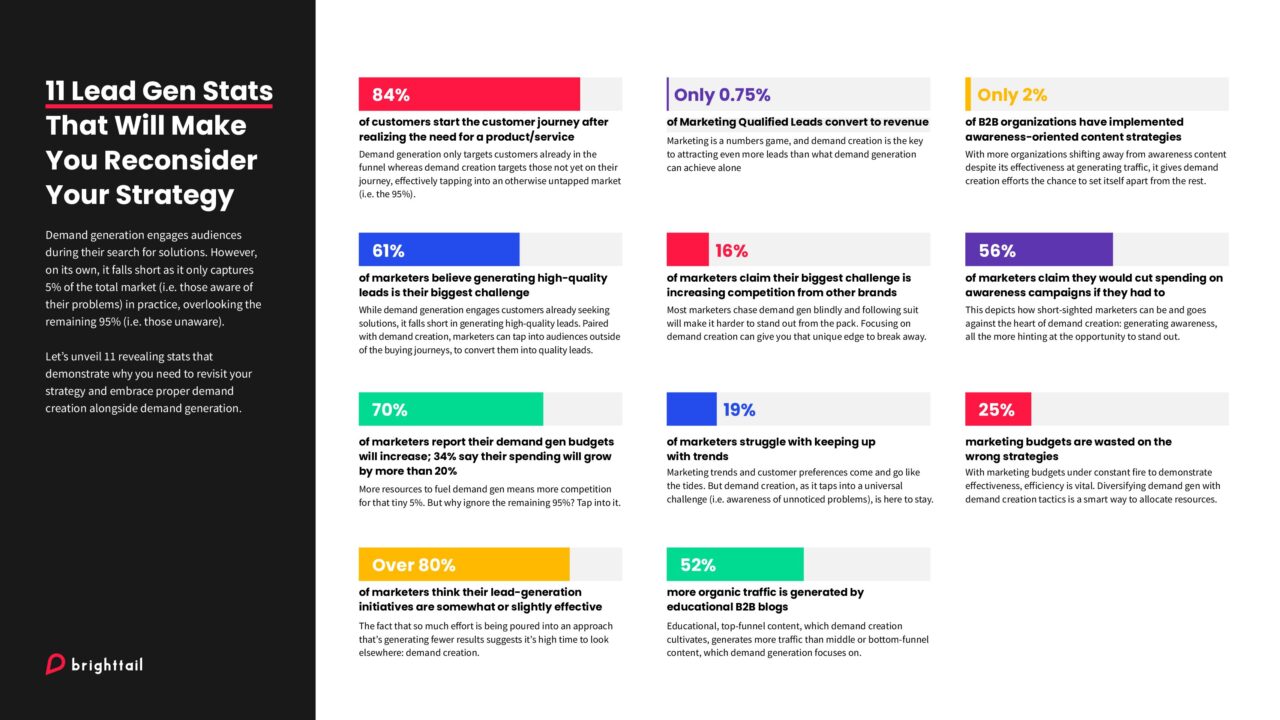As a marketing leader, you understand that to survive in the rapidly changing landscape of marketing, success belongs to those who constantly search for fresh perspectives and data-driven insights. Today, with customer acquisition costs (CACs) skyrocketing higher than ever, the need to secure high-intent leads is second to none.
While it’s reasonable to lean on tried-and-true methods given the complexities of marketing, it’s crucial to remain open to other approaches to secure a competitive edge and stay ahead of the curve.
Specifically, let’s talk about demand generation. Sure, it’s dependable and forms the backbone for the majority of marketers but relying on it alone means two things: fighting for a shrinking segment of the market and becoming stale. Everyone knows about demand generation and is probably doing it already, so how do you, as a marketer, stand out?
Enter: demand creation.
What Is Demand Creation and Why You Need It
Imagine you’re a cybersecurity company. Your target audience (e.g., IT professionals, CIOs, SMEs) is indeed aware of cyber threats and appropriate solutions. But given the universal nature of cybersecurity challenges, you might ask: what about everyone else? how do I go beyond and reach audiences who are not yet aware of these threats and solutions?
This is precisely what demand creation aims to do.
Demand creation is all about igniting interest among untapped audiences who are unaware of their problems and aren’t seeking solutions just yet. In contrast, demand generation only engages audiences who are already aware of their problems and are actively seeking solutions.
Though demand generation forms the linchpin of many marketing campaigns, it’s limited at its core in how it is only able to capture 5% of the total addressable market, i.e. the aware ones.
While technically demand generation includes the idea of creating new demand, this aspect is frequently overlooked in practice. Many businesses prioritize measuring short-term ROI through easily measurable sales activation campaigns, which leads to demand generation becoming synonymous with demand capture—focusing solely on the 5% actively seeking solutions. Because of this demand creation, which is harder to track and requires a longer runway for results, often takes a back seat.
Essentially, to tap into the remaining 95%, you need to start creating demand. Through a blend of thought leadership, brand building, and content marketing efforts, unaware audiences can be informed and converted into leads, effectively going beyond the limits of demand generation.

The Limits of Demand Generation in 11 Revealing Stats
Centering your marketing efforts solely on demand generation is like fighting for a shrinking piece of the pie (i.e. the 5%) while ignoring how that very pie has countless other pieces (i.e. the 95%).
And if you think this seems nonsensical, we understand.
To thrive in today’s competitive landscape, thinking outside the box with demand creation is key. You have to see the pie beyond a single piece, metaphorically speaking. Here’s why:
1. 84% of customers start the customer journey after realizing the need for a solution
Most customers only begin their funnel journey after becoming aware of their problems and possible solutions. This underscores the limits of demand generation: it only targets customers who are already in the funnel.
But what about those who aren’t? This otherwise untapped 95% of the market is what demand creation addresses by kickstarting unaware customers on their journey down the funnel.
2. 61% of marketers believe generating high-quality leads is their biggest challenge
Securing high-quality leads is tough. While demand generation is a solid method to engage those already in search of a solution, it doesn’t guarantee quality.
Demand creation efforts can enhance lead quality. Because it targets totally uninformed prospects, it allows marketers to craft a tailored journey from awareness to decision. If done right, this can foster stronger relationships and eventually convert prospects into quality leads.
3. 70% of marketers report their demand gen budgets will increase; 34% say their spending will grow by more than 20%
With the majority of marketers increasing their spending on demand gen efforts, this only means that competition for the 5% of the pie is getting fiercer.
This is a shame, as, unlike demand creation, this only captures a fraction of the total addressable market, leaving the remaining 95% untapped. Why go against the tide when you can swim with it?
4. Over 80% of marketers think their lead-generation initiatives are somewhat or slightly effective
Here’s the twist: Though this is the case, more resources than ever are being poured into efforts that are producing diminishing returns.
This disconnect is an indicator that perhaps it is time to start thinking outside of the tried-and-tested box, such as embracing alternate approaches like demand creation.
5. Only 0.75% of Marketing Qualified Leads (MQLs) convert to revenue
Though this statistic is sobering, it underpins the reality that successful marketing = a numbers game.
This emphasizes the need to look beyond the 5%. With demand creation, a wider net can be cast, maximizing the number of potential leads so as to increase the odds of conversion.
6. 16% of marketers claim their biggest challenge is increasing competition from other brands
This shouldn’t surprise anyone. With competition steadily increasing, staying confined to traditional demand generation methods means contending in an ever-more-crowded arena.
Here’s an idea: it’s time to switch lanes with demand creation. Now, more than ever, marketers must identify fresh avenues for differentiation and engagement.
7. 19% of marketers struggle with keeping up with trends
B2B trends are as fickle as the wind. They fluctuate heavily based on rapidly changing preferences, tastes, and competitor influence. This is why focusing on fulfilling existing demand alone is like boarding a soon-to-sink boat.
Keeping a tab on current trends while also consciously creating new demands, can help you address something more fundamental and enduring: awareness of unnoticed problems.
8. 52% more organic traffic is generated by educational B2B blogs
Demand creation is about educating individuals who aren’t aware of their problems, making top-funnel content a focal point.
Here’s why this matters: educational blogs, which demand creation thrives on, generate more traffic compared to the middle and bottom-funnel blogs which demand generation places emphasis on.
9. Only 2% of B2B organizations have implemented awareness-oriented content strategies
This is a missed opportunity that highlights how awareness content is ripe for the taking, allowing demand-creation-driven marketers to shine where others are shying away from.
By focusing heavily on awareness content, you can gain a competitive edge, allowing you to stand out in the minds of consumers before consumers even know about solutions let alone your competitors’ solutions.
10. 56% of marketers claim they would cut spending on awareness campaigns if they had to
This is wholly contrary to the fact that awareness content generates significant traffic and the entire premise of demand creation: education.
An approach like this is short-sighted and can hamper long-term sustainability and competitiveness.
11. 25% of marketing budgets are wasted on the wrong strategies
We all know how marketing budgets are stretched tight, necessitating the need to be as efficient as possible and to minimize wastage.
Given the limitations of demand-gen-focused strategies as seen above, marketers must incorporate demand creation into their strategy to get the most bang for their buck.

Demand Generation and Creation Are Interdependent
While we’ve highlighted the shortcomings of demand generation above, here’s a caveat. We’re not saying that demand creation > demand generation. They’re complementary like bread and butter, and when combined, make a tasty snack. But on their own? Not as delicious.
Demand creation gets people into the store by cultivating demand whereas demand generation convinces people to buy something. They’re both crucial, synergistic pieces of the marketing puzzle and without harnessing both, the full potential of your marketing efforts will never be realized.
Now that we’ve established the importance of demand creation, why not continue your journey by diving into the importance of long-term thinking and planning for marketing?



